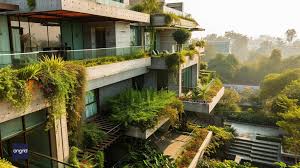Exploring the Beauty and Benefits of Sustainable Landscape Architecture

The Importance of Sustainable Landscape Architecture
Sustainable landscape architecture is an essential component of environmentally conscious design that focuses on creating outdoor spaces that are both aesthetically pleasing and ecologically friendly. By incorporating sustainable practices into landscape architecture, designers can help mitigate the impact of urban development on the environment while also providing numerous benefits to communities and ecosystems.
Benefits of Sustainable Landscape Architecture:
- Environmental Preservation: Sustainable landscape architecture helps preserve natural resources, reduce water consumption, and promote biodiversity by using native plants, green infrastructure, and efficient irrigation systems.
- Climate Resilience: By designing landscapes that can withstand climate change impacts such as extreme weather events and rising temperatures, sustainable landscape architecture plays a crucial role in building resilient communities.
- Improved Air and Water Quality: Green spaces created through sustainable landscape design help improve air quality by absorbing pollutants and provide natural filtration for rainwater runoff, reducing pollution in water bodies.
- Social Benefits: Sustainable landscapes contribute to the well-being of communities by offering recreational spaces, promoting physical activity, reducing stress, and fostering a sense of connection to nature.
- Economic Value: Well-designed sustainable landscapes can increase property values, attract businesses and tourists, and reduce maintenance costs over time through efficient use of resources.
Key Principles of Sustainable Landscape Architecture:
- Biodiversity Conservation: Incorporating native plant species to support local wildlife and create resilient ecosystems.
- Water Conservation: Implementing water-efficient irrigation systems, rain gardens, permeable surfaces, and water harvesting techniques to reduce water consumption.
- Energy Efficiency: Using trees and vegetation strategically to provide shade in summer and wind protection in winter, reducing energy needs for heating and cooling.
- Maintenance Minimization: Designing low-maintenance landscapes with drought-tolerant plants to reduce the need for chemical inputs and excessive watering.
- Social Equity: Creating inclusive public spaces accessible to all members of the community while considering cultural heritage and social needs.
In conclusion, sustainable landscape architecture is a vital practice that promotes environmental stewardship, enhances community well-being, and contributes to a more resilient future. By integrating sustainable principles into landscape design projects, architects can create beautiful outdoor spaces that benefit both people and the planet.
Understanding Sustainable Landscape Architecture: Key Concepts, Environmental Benefits, and Community Impact
- What is sustainable landscape architecture?
- Why is sustainable landscape architecture important?
- How can sustainable landscape architecture benefit the environment?
- What are the key principles of sustainable landscape architecture?
- How does sustainable landscape architecture contribute to community well-being?
What is sustainable landscape architecture?
Sustainable landscape architecture is a design approach that prioritizes creating outdoor spaces in a way that minimizes environmental impact, promotes ecological health, and enhances the well-being of communities. It involves integrating principles of environmental sustainability, resource efficiency, and social responsibility into the planning and design of landscapes. Sustainable landscape architecture aims to conserve natural resources, reduce energy consumption, support biodiversity, manage water efficiently, and create resilient outdoor environments that can adapt to changing climate conditions. By incorporating sustainable practices such as using native plants, green infrastructure, and eco-friendly materials, sustainable landscape architecture seeks to harmonize human activities with nature while fostering healthier and more vibrant outdoor spaces for people to enjoy.
Why is sustainable landscape architecture important?
Sustainable landscape architecture is crucial for various reasons, primarily due to its significant positive impact on the environment and communities. By prioritizing sustainability in landscape design, architects can help conserve natural resources, promote biodiversity, and mitigate the effects of climate change. Sustainable landscapes also play a key role in improving air and water quality, enhancing the overall well-being of communities, and fostering a sense of connection to nature. Additionally, sustainable landscape architecture contributes to economic value by increasing property values, attracting businesses and tourists, and reducing long-term maintenance costs through efficient resource management. Overall, the importance of sustainable landscape architecture lies in its ability to create resilient, visually appealing outdoor spaces that benefit both people and the planet.
How can sustainable landscape architecture benefit the environment?
Sustainable landscape architecture offers numerous benefits to the environment by incorporating eco-friendly practices that promote conservation and restoration. By using native plant species, implementing efficient irrigation systems, and creating green spaces that support biodiversity, sustainable landscape architecture helps reduce water consumption, mitigate pollution, and preserve natural habitats. Additionally, sustainable landscapes contribute to carbon sequestration, improve air quality, and enhance soil health, ultimately fostering healthier ecosystems and mitigating the impacts of urban development on the environment. Through thoughtful design and implementation, sustainable landscape architecture plays a crucial role in promoting environmental sustainability and creating resilient landscapes for future generations.
What are the key principles of sustainable landscape architecture?
The key principles of sustainable landscape architecture encompass various strategies aimed at promoting environmental conservation, resource efficiency, and social well-being. These principles include biodiversity conservation through the use of native plant species to support local ecosystems, water conservation through efficient irrigation systems and rainwater harvesting techniques, energy efficiency by strategically placing vegetation for natural cooling and heating effects, maintenance minimization with low-maintenance landscaping designs, and social equity considerations to create inclusive public spaces that cater to diverse community needs. By adhering to these key principles, sustainable landscape architecture strives to create harmonious outdoor environments that benefit both people and the planet for generations to come.
How does sustainable landscape architecture contribute to community well-being?
Sustainable landscape architecture plays a crucial role in enhancing community well-being by creating outdoor spaces that promote social interaction, physical activity, and mental health. By incorporating green spaces, parks, and community gardens into urban environments, sustainable landscape architecture provides residents with opportunities for relaxation, recreation, and connection to nature. These green areas offer a refuge from the hustle and bustle of city life, reduce stress levels, and improve overall quality of life for community members. Additionally, sustainable landscape design can address environmental issues such as air and water pollution, urban heat islands, and climate change impacts, contributing to a healthier and more sustainable living environment for all residents.
